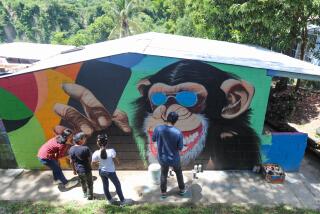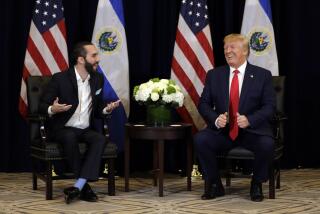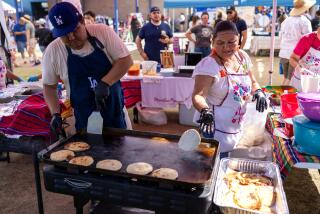Rebels’ Rally Welcomes Peace in San Salvador
- Share via
SAN SALVADOR — With ringing church bells and exploding fireworks, religion and rock ‘n’ roll, thousands of Farabundo Marti National Liberation Front guerrillas and their supporters celebrated the end of a 12-year civil war Thursday under a searing midday sun in downtown San Salvador.
Rebel banners draped the Metropolitan Cathedral, where two rebel radio stations--Venceremos and Farabundo Marti--broadcast live to combatants in the mountains.
Emboldened by the signing of the peace accords in Mexico, many in the crowd waved red “FMLN” flags and wore T-shirts emblazoned with the guerrilla insignia--as if the letters stood for a university team rather than a clandestine army.
“This is beautiful. We’re tired of so much war,” said Amilcar Aguirre, 23, a bricklayer waving a flag. “Before, if you carried a flag like this, they killed you. But it’s different now. We have the agreements.”
For the first time since the war began, the Farabundo Marti Front appeared with paid advertisements on mainstream radio and television and in the right-wing newspaper Prensa Grafica. They had been denied the space before.
Throughout the day, Salvadoran television showed scenes from more than a decade of violence that has claimed more than 75,000 lives: guerrillas in training, government soldiers spilling out of a helicopter, civilians fleeing combat and the U.S. Border Patrol nabbing illegal immigrants. It recalled the rebel kidnaping of then-President Jose Napoleon Duarte’s daughter in 1985 and her return 44 days later in exchange for 37 guerrilla prisoners.
Leftist and right-wing politicians assassinated during the conflict were shown alive in interviews, then dead at their gruesome murder scenes.
Viewers saw Archbishop Oscar Arnulfo Romero of San Salvador gunned down by a right-wing death squad while saying Mass in March, 1980. “I beg you, I plead with you, in the name of God . . . stop the repression,” Romero said in a recording of one of his most famous sermons.
Jaime Molino, 35, recalled the horror of Romero’s funeral, which erupted in bloody chaos when explosions went off among the mourners and unidentified gunmen fired from the National Palace.
“I was here when they buried Romero and at first I was afraid to come back,” Molino said as he stood on the second floor of the now-abandoned palace. “But then I felt we had sufficient guarantees (with the accords). I am happy that we have symbolically taken the palace.”
Nearby, Francisca Merina, 56, looked over the packed plaza with wide eyes. “I came to show my support for so much hope,” said the farmer from San Vicente. “The armed forces recruited my son off a bus eight years ago. They wouldn’t give him back to me, and a year later they brought him to me dead,” Merina said.
At another window, a rebel medic who called himself Isabel Martinez, also watched the crowd. “I am very happy. We don’t have to be afraid anymore,” Martinez said.
Originally a farmer from Aguilares, in Chalatenango province, Martinez said he joined the guerrillas in 1979 after a death squad killed the grandparents who raised him and a brother. He would lose 22 family members in all before the end of the war.
“Yes, I feel anger over the dead, but now we all have to change. There is going to be justice,” Martinez said, adding that as a rebel surgeon’s assistant, he had operated on wounded soldiers as well as guerrillas.
Martinez joined a group of young men gathered around a tiny, portable television set as the government and rebel leaders signed the accord for political and military reforms and a Feb. 1 cease-fire. As his commander, Leonel Gonzalez, put his name to the agreement, Martinez smiled and choked: “That’s wonderful. . . . I don’t know what to say.”
Nelson Alexander, a construction worker, lifted his 9-year-old son up to the screen.
“They’re signing,” he told the boy in a whisper. “I want him to understand that this is an important day for El Salvador,” he explained.
Francisco, 18, was one of the scores of war-wounded milling about the palace and plaza. The youth from Chalatenango province lost his right leg to a mine in 1989, he said, as he leaned on a single crutch. He and the rest of the crowd cheered wildly as six rebel commanders took the stage in civilian dress to announce that they and the Farabundo Marti Front would work for national reconciliation and the reconstruction of El Salvador.
“Today a new day is born with the winds of peace, democracy and social justice,” said Juan Ramon Medrano, alias Commander Baltazar. “Today, we are beginning to put an end to 60 years of militarism. We have put a date on the reduction, purification, reorientation and redefinition of the role of the armed forces that have dominated the people for decades.”
But while Medrano came into the daylight unarmed and using his legal name, a scattering of young boys kept their faces covered with red bandannas. And in the cathedral, which is closed for remodeling, uniformed rebels patted down reporters who made their way up to clandestine radio transmitters in the church towers.
“We came on the bus with the people,” said Cmdr. Santiago Gallo of Radio Venceremos, explaining how he made his way from the mountains to San Salvador. “Hundreds of buses came from all over the country today and on one of those buses came Radio Venceremos.”
Archbishop Arturo Rivera y Damas of San Salvador had asked all the Catholic churches to ring their bells at noon. Rebels rang the bells of the Metropolitan Cathedral, while their supporters tossed confetti from the roof. They were elated at their new-found freedom to demonstrate sympathy for the guerrillas.
In the evening, the ruling Nationalist Republican Alliance, or Arena party, rallied several thousand government supporters in another plaza a block away. Beneath banners proclaiming “Cristiani, the president of peace,” they sang the Arena song, which includes the phrase “El Salvador will be the tomb where the Reds will end up. . . .”
The demonstrators, however, appeared ready to bury the war. Few were concerned about the rebel rally nearby.
“This is a great day,” said mechanic Joaquin Flores. “This is what the people wanted--peace. In a democracy, we all have a right to express what we think.”
In El Salvador, that hasn’t always been the case.
More to Read
Sign up for Essential California
The most important California stories and recommendations in your inbox every morning.
You may occasionally receive promotional content from the Los Angeles Times.










